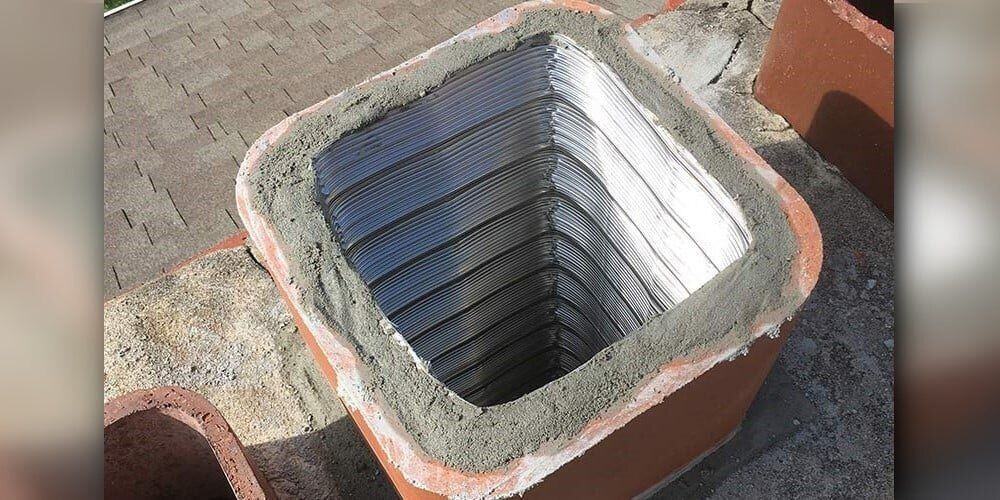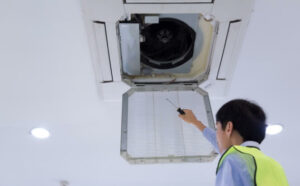Chimney liners don’t get the sort of appreciation they deserve.
In fact, they’re so important that the National Bureau of Standards found that chimneys without liners allowed heat to move so rapidly that adjacent woodwork caught fire in a mere three and a half hours.
That’s less time than it would take you to watch a movie.
You might be taking your chimney for granted, but it’s actually playing an important role in your house’s well-being.
So what exactly is a chimney liner? Why should you care about it? And do you need chimney liner repair? Let’s break it down.
What Is a Chimney Liner?
A chimney liner is a protective barrier that lines the inside of your chimney from top to bottom. It helps create a smooth, safe pathway for smoke, gases, and heat to travel from your fireplace and out of your home.
Most chimney liners are made from one of three materials:
- Clay tiles
- Stainless steel
- Cast-in-place cement
The liner sits between the actual structure of your chimney and whatever’s flowing through it. That could be wood smoke from your fireplace, exhaust from your gas furnace, or fumes from your oil-burning heating system.
Why Do You Need a Chimney Liner?
Your chimney wasn’t built to handle direct contact with hot gases and corrosive byproducts. Without a liner, all that heat, moisture, and acidic condensation eats away at your chimney’s masonry over time. This leaves you with expensive repairs that could have been avoided in the first place.
Here are some of the main reasons why chimney liners matter:
1. Fire Protection
Fire protection is the most important reason. Without a chimney liner, you’re putting your home at risk of a full-blown fire. That’s not a risk you want to take with your home.
A proper chimney liner installation keeps that intense heat contained and directs it safely up and out of your chimney. Without it, that heat can transfer directly through your chimney walls to the wooden framing of your house.
2. Protecting Your Chimney Structure
Your chimney’s masonry wasn’t designed to handle the corrosive byproducts of combustion. When you burn wood, gas, or oil, you’re creating moisture, acids, and other chemicals that can eat away at mortar joints and brick over time.
A liner acts as a barrier, protecting your chimney’s structural integrity.
3. Proper Ventilation
Here’s an advantage you probably weren’t aware of: your chimney liner needs to be properly sized for your heating appliance to work efficiently. Too big, and the draft won’t be strong enough to pull smoke and gases up and out. Too small, and you’ll get poor combustion and potential backdrafting.
A properly sized liner ensures your fireplace, furnace, or stove operates safely and efficiently.
4. Preventing Carbon Monoxide Poisoning
This one’s literally a matter of life and death. If your liner is cracked or damaged, deadly carbon monoxide can leak into your living spaces instead of being safely vented outside.
According to the CDC, more than 400 Americans die from unintentional carbon monoxide poisoning each year, and thousands more are hospitalized. A properly functioning chimney liner could be the difference between life and death.
Types of Chimney Liners
We touched briefly on the three materials chimney liners are typically made of. Here’s a closer look at them:
1. Clay Tile Liners
If you live in an older home, chances are you already have clay tile liners. These have been the standard for decades, and for good reason:
These liners are relatively cheaper, they’ll outlast you if you maintain them properly, and are great for wood-burning fireplaces. But that doesn’t mean they don’t have their downsides. Clar tile liners are difficult and expensive to repair if damaged. They’re not ideal for modern heating appliances and may even crack from rapid changes in temperature.
2. Stainless Steel Liners
Most professionals swear by stainless steel liners since they’re suitable for all fuel types, including wood, gas, and oil. They’re also highly durable, resistant to corrosion, can be installed relatively quickly, and are available in both flexible and rigid options.
The downside? They’re heavier on your pocket upfront compared to clay tile liners.
3. Cast-in-Place Liners
These are essentially concrete liners that are formed right inside your existing chimney. They create a seamless, insulated liner, strengthen the entire chimney structure, and are excellent for older chimneys that may have structural issues.
These liners do come at a steeper price; they’re also permanent, so they’re not easy to remove, and they may reduce the opening size of your chimney.
Also Read: What is the Best Time of the Year for Chimney Cleaning?
When Do You Need Chimney Liner Repair?
You now know why chimeny liners are crucial. Great. But how do you know if your current liner needs attention?
Here’s what you need to look for:
1. White Staining on Your Chimney
Those white, chalky stains you see on your chimney’s exterior? That’s efflorescence, and it’s a sign that moisture is getting into your chimney system. This often indicates chimney liner problems.
2. Rust on Your Damper or Firebox
If you’re seeing rust in your fireplace, it usually means moisture is getting where it shouldn’t be, often through a damaged liner.
3. Damaged Chimney Crown
A cracked chimney crown can allow water to seep down into your chimney, causing your liner to break down a lot faster than it should. Professional chimney crown repair helps prevent costly damage, protects your chimney structure, and extends the life of your system.
4. Spalling Bricks
If the bricks on your chimney are crumbling or flaking off, it could be a sign that acidic condensation from a damaged liner is eating away at your masonry.
5. Ageing Chimney Liner
Even if you don’t see obvious signs of damage, age is a factor. Clay tile liners typically last 50+ years, while stainless steel liners can last 15-20 years depending on usage and maintenance.
The Hidden Costs of NOT Having a Proper Liner
Most homeowners wonder if they can do without a chimney liner. The answer is a resounding no. You might be tempted to cut corners, but skipping chimney liner repairs or a liner altogether, but here’s why that could be the most expensive mistake you make:
1. Structural Damage
Without proper protection, the acidic byproducts of combustion will gradually eat away at your chimney’s mortar and bricks. What starts as a liner replacement job can turn into a complete chimney rebuild. You’re looking at a figure that crosses $10,000.
2. Insurance Issues
Many insurance companies won’t cover fire damage if it’s determined that you had a damaged or missing chimney liner. That’s a risk that could cost you everything.
3. Reduced Home Value
A damaged chimney system can be a turnoff for potential buyers. Having a properly lined chimney shows that you’ve maintained your home’s critical safety systems.
4. Health Risks
Beyond the fire risk, a compromised liner can allow carbon monoxide and other toxic gases into your home. The health consequences can be severe or even fatal.
DIY vs. Professional Installation: Is It Worth the Risk?
You’re probably wondering if you could pull this off yourself with a few YouTube video guides and a buddy’s help. But here’s why installing a chimney liner isn’t a weekend job:
Safety
Working on a roof and inside a chimney is dangerous. Professional installers have the right equipment and experience to do the job safely. This isn’t the same as changing the light bulb, and you definitely don’t want to risk hurting yourself on the job.
Code Compliance
NFPA 211 has specific requirements for chimney installation and chimney liner installation, and getting it wrong could put your family at risk and void your insurance coverage.
Proper Sizing
Getting the liner size wrong can be dangerous and expensive. Professionals know how to properly size liners for optimal performance and safety.
How to Choose a Chimney Liner Professional?
If we’ve convinced you to hire a professional to handle the job for you, you’re probably wondering what you need to look for in a potential candidate. Here’s what you should consider:
- Certifications: Look for contractors certified by the Chimney Safety Institute of America (CSIA) or the National Chimney Sweep Guild (NCSG).
- Local References: Ask for recent local references and actually call them. A reputable contractor will be happy to provide them.
- Written Estimates: Get detailed written estimates from at least three contractors. Be wary of significantly high or low bids.
- Insurance and Licensing: Make sure your contractor is properly licensed and carries liability insurance.
How Do You Maintain Your New Chimney Liner?
You’ve installed a new chimney liner, and now you’re wondering how you can maintain that investment you just made. Proper maintenance can help your chimney liner last a lot longer compared to one that’s not loved as much. Here’s what you can do to prevent untimely chimney liner repairs:
- Annual Inspections: Have your chimney inspected annually by a certified professional, even if you don’t use it regularly. There’s a good chance you’ll catch something before it becomes a full-blown issue.
- Regular Cleaning: Wood-burning fireplaces should be cleaned annually; anything less than that and you’re doing it wrong. Gas appliances need less frequent cleaning but should still be checked regularly.
- Address Issues Quickly: Don’t ignore signs of problems. Small issues are much cheaper to fix than big ones.
Your Safety Is Worth the Investment
We tell homeowners this all the time: when it comes to your home, your family, and your safety, you can never be too careful.
Sure, a chimney liner isn’t the most exciting home improvement you’ll ever make. You can’t show it off to your friends, and it won’t make your Instagram feed more interesting. But it might just save your life.
About 75 years ago, researchers concluded that it is “practically criminal” to build a chimney without a lining because it is such an unsafe practice. That hasn’t changed.
If you’re unsure about the condition of your chimney liner, don’t wait. Have it inspected by a certified professional. The peace of mind is worth every penny, and the safety of your family is priceless.
Your chimney liner might be hidden from view, but its importance to your home’s safety can’t be overstated. Whether you’re dealing with an older home with clay tiles or considering an upgrade to stainless steel, make sure this critical safety component gets the attention it deserves. Reach out to Omega Duct Cleaning today and let us handle your chimney liner repair for you.




